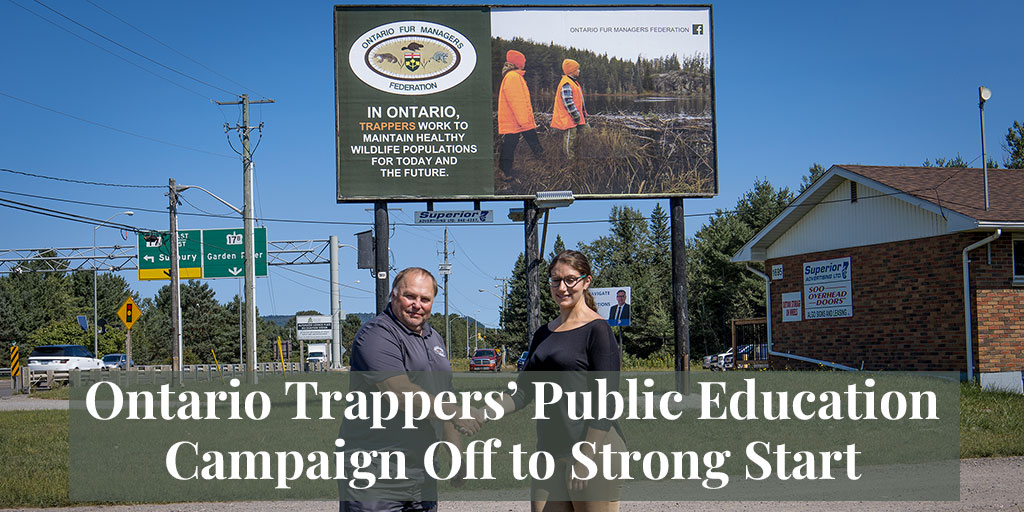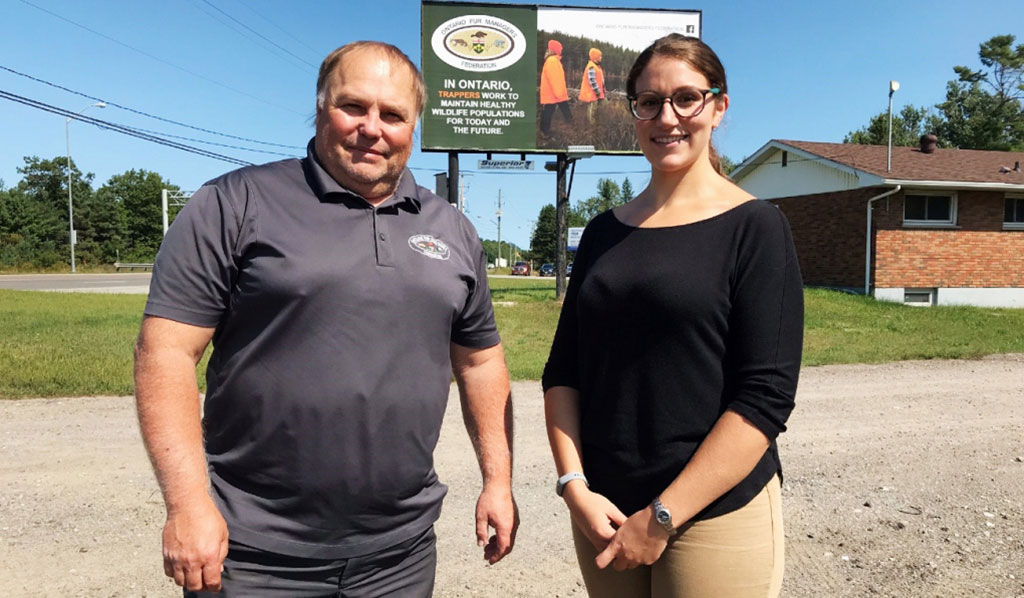
A billboard campaign by Ontario trappers to raise public appreciation of their role in wildlife management has so far been well received. Now the organisation behind the campaign, the Ontario Fur Managers Federation (OFMF), is optimistic a national campaign can follow.
From September 5 to October 14, the OFMF has six billboards on show near high-traffic border crossings to the US. The message on the billboards is simple, but thought-provoking: “In Ontario, trappers work to maintain healthy wildlife populations for today and the future.”
The idea, explains Robin Horwath, who retired this August after 12 years as OFMF’s general manager, is that discussion of this key message will lead to discussion of other important aspects of trapping. These include protecting habitat, property and infrastructure, controlling the spread of diseases, and of course, supplying consumers with beautiful, sustainable and natural furs.
SEE ALSO: Robin Horwath – Trappers are “great stewards of the land”. Truth About Fur.
“Wildlife managers and conservationists have always appreciated the important work trappers do, and call on us to help all the time,” explains Horwath, a third-generation trapper from Blind River. “But among the general public, there are many misunderstandings about what we do. In the first stage of this campaign, we hope to generate interest in local media, and use that as a platform to explain ourselves better.”
The response so far has been encouraging. As of this writing, the campaign has been covered by SooToday of Sault Ste. Marie, Windsor News Today, TBnewswatch of Thunder Bay, Timmins Today, the program Superior Morning on CBC Radio, and CTV News (click on the image below to view).
“If this campaign succeeds in raising the understanding and acceptance of trapping among Ontarians, we hope other trapping associations will be inspired to follow suit, and we’ll have a national campaign going,” says Horwath.
Modern Traps Are Humane

So in what ways are trappers currently misunderstood?
“Over the years, many misconceptions and outdated information have been spread when it comes to trapping,” explains Lauren Tonelli, also a third-generation trapper and Horwath’s replacement as general manager of the OFMF. “A lot of this comes from a place of ignorance about trapping, which is what we are trying to correct. However, there are groups that are anti-trapping that spread this misinformation in an attempt to sway people’s opinions against trappers. One of the major pieces of misinformation being spread around is that trappers still use inhumane steel-jawed leghold traps, and that animals lose feet in them trying to escape. This is simply not true.”
“Steel-jawed legholds have been banned for decades,” she continues. “In fact, the modern equivalents are foothold traps, with padded offset jaws and swivels that can also be used for relocating live animals.”
In support of her claim, she points to the website of the Fur Institute of Canada, which has been at the forefront of developing humane traps since it was established in 1983. Here can be found illustrated lists of all the trap types currently certified under the Agreement on International Humane Trapping Standards (AIHTS).
“Canadian trappers are bound by AIHTS on what types of traps they can use,” says Tonelli, “which are certified and specifically designed to restrain an animal humanely, until the trapper arrives, or designed to kill the animal instantly. What you will not find are the steel-jawed leghold traps described by anti-trapping groups.”
Reducing Disease, Starvation
Another misconception that the OFMF wants to dispel is that all wildlife populations are just fine on their own and don’t need any sort of management.
Wildlife populations fluctuate in response to several factors, including changes in food supply, how many predators there are, habitat and climate, and without human intervention, these fluctuations can be extreme.
“The way that populations regulate themselves without intervention consists of starvation, predation, and disease,” says Tonelli. “When wildlife populations become overabundant, they are much more prone to disease outbreaks. We all understand how crowded groups of people lead to spread of disease, and it is no different in animals. This can lead to massive die-offs and significant population declines. Additionally, animal populations can grow to a point where there is not enough available food to go around, which also leads to crashes in the population. Trappers help to maintain consistent, sustainable populations that are not reaching levels where disease spread is rampant, and starvation occurs.”
SEE ALSO: Does wildlife need to be managed? Ontario Fur Managers Federation.
Other key points the OFMF is keen to discuss are:
- Sustainability: Fur is a renewable natural resource, unlike synthetic materials like polyester. Fur garments can be restyled and repaired, and after decades of use, biodegrade rather than clogging landfills.
- Property and infrastructure damage: Beavers are believed to be more numerous in Ontario today than ever before, but they must be managed. Beavers can destroy woodlands, and their dams can flood homes, roads and fields.
- Saving taxpayers’ money: By helping wildlife managers, trappers also reduce the cost of management to taxpayers.
- Controlling livestock predation: Trappers are often asked by livestock farmers to control predation by coyotes. Particularly vulnerable are calves and lambs.
For further information, or to arrange an interview with an OFMF representative, please contact general manager Lauren Tonelli at 705-542-4017 or [email protected].

SEE ALSO: Fur fights back. Ontario trappers launch new public education campaign. Truth About Fur.
***
To learn more about donating to Truth About Fur, click here.










